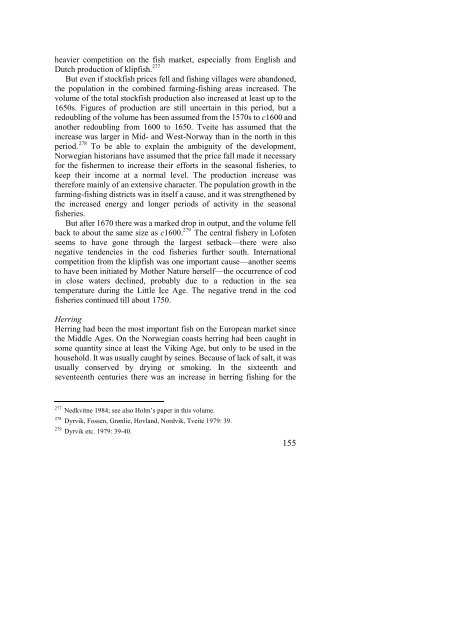The North Atlantic Fisheries, 1100-1976 - University of Hull
The North Atlantic Fisheries, 1100-1976 - University of Hull
The North Atlantic Fisheries, 1100-1976 - University of Hull
You also want an ePaper? Increase the reach of your titles
YUMPU automatically turns print PDFs into web optimized ePapers that Google loves.
heavier competition on the fish market, especially from English and<br />
Dutch production <strong>of</strong> klipfish. 277<br />
But even if stockfish prices fell and fishing villages were abandoned,<br />
the population in the combined farming-fishing areas increased. <strong>The</strong><br />
volume <strong>of</strong> the total stockfish production also increased at least up to the<br />
1650s. Figures <strong>of</strong> production are still uncertain in this period, but a<br />
redoubling <strong>of</strong> the volume has been assumed from the 1570s to c1600 and<br />
another redoubling from 1600 to 1650. Tveite has assumed that the<br />
increase was larger in Mid- and West-Norway than in the north in this<br />
period. 278 To be able to explain the ambiguity <strong>of</strong> the development,<br />
Norwegian historians have assumed that the price fall made it necessary<br />
for the fishermen to increase their efforts in the seasonal fisheries, to<br />
keep their income at a normal level. <strong>The</strong> production increase was<br />
therefore mainly <strong>of</strong> an extensive character. <strong>The</strong> population growth in the<br />
farming-fishing districts was in itself a cause, and it was strengthened by<br />
the increased energy and longer periods <strong>of</strong> activity in the seasonal<br />
fisheries.<br />
But after 1670 there was a marked drop in output, and the volume fell<br />
back to about the same size as c1600. 279 <strong>The</strong> central fishery in L<strong>of</strong>oten<br />
seems to have gone through the largest setback—there were also<br />
negative tendencies in the cod fisheries further south. International<br />
competition from the klipfish was one important cause—another seems<br />
to have been initiated by Mother Nature herself—the occurrence <strong>of</strong> cod<br />
in close waters declined, probably due to a reduction in the sea<br />
temperature during the Little Ice Age. <strong>The</strong> negative trend in the cod<br />
fisheries continued till about 1750.<br />
Herring<br />
Herring had been the most important fish on the European market since<br />
the Middle Ages. On the Norwegian coasts herring had been caught in<br />
some quantity since at least the Viking Age, but only to be used in the<br />
household. It was usually caught by seines. Because <strong>of</strong> lack <strong>of</strong> salt, it was<br />
usually conserved by drying or smoking. In the sixteenth and<br />
seventeenth centuries there was an increase in herring fishing for the<br />
277 Nedkvitne 1984; see also Holm’s paper in this volume.<br />
278 Dyrvik, Fossen, Grønlie, Hovland, Nordvik, Tveite 1979: 39.<br />
279 Dyrvik etc. 1979: 39-40.<br />
155















